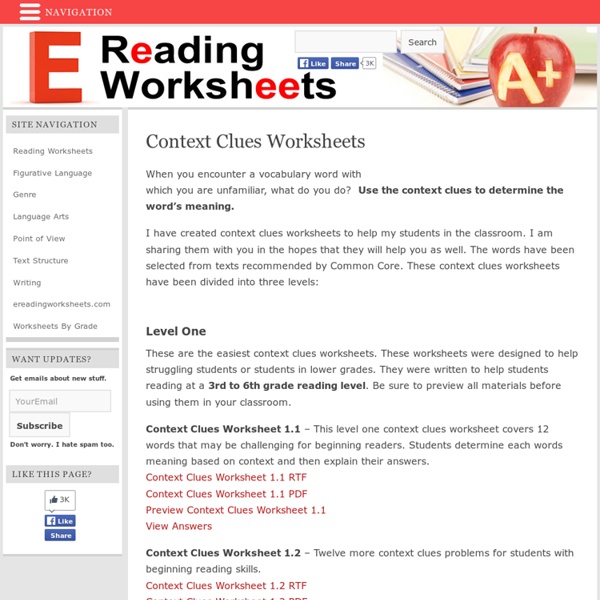- Apps for Core Literature Standards, grades 6-12
0 Comments November 17, 2011 By: Vicki Windman Nov 17 Written by: 11/17/2011 3:46 AM ShareThis The standards for these grade overlap- apps will coincide for middle school. The standard calls for the following skills: Cite textual evidence to support analysis of what the text says explicitly as well as inferences drawn from the text. Apps: Minimod for inferences $3.99 Appropriate for 6th graders or students who may be struggling with this concept. Margins $3.99 Margins keeps notes organized by book and page number. Literary Analysis Guide $2.99 By arranging the elements of literature graphically around three wheels (poetry, prose, and rhetoric), teachers and students are better able to visualize how the elements of literature develop style and meaning. Total Recall Free A color-coded mind map to help students break down theme, central ideas, characters, etc. Range of Reading and Text Complexity – grades 6-12 Apps: Vicki Windman is a special education teacher at Clarkstown High School South.
Resource Library
<a href=" title="Contact us" target="_blank">Questions? Feedback?</a> powered by <a href=" title="Olark live chat software">Olark live chat software</a> Select Standard Show Resources by Standard Subject Resource Library Grade Resource Type Showing 11 - 20 of 14715 Resources Featured Writing Informative Texts Rheanna Williams License: Creative Commons (CC BY) Standards: 8.W.2 Grades: 8 Standards: 5.W.2 Grades: 5 Reading Visual Information Kayte Jones Standards: 4.RI.7 Grades: 4 Gathering Relevant Information Mike Lucas Standards: 8.W.8 Write Informative/Explanatory Texts Lucy Roberts Standards: 7.W.2 Grades: 7 Standards: 4.W.2 Vocabulary in Informational Texts Standards: 4.RI.4 Standards: 1.W.2 Grades: 1 Standards: 2.W.2 Grades: 2 Explaining Informational Texts Standards: 4.RI.3 Search the largest K-12 resource collection - over a million lesson plans, assessments, videos, and games. Tell Us About Your Teaching (Optional)
Reading Worksheets
Fourth Grade Reading Comprehension Test Collection – 9 Tales of 9 Tails: Use the information in the story to answer the 5 comprehension questions. Answer Key Is Included. Each story is part of an ongoing story of self-discovery and growth of a 9-tailed fox. The First TailThe Second TailThe Third TailThe Fourth TailThe Fifth TailThe Sixth TailThe Seventh TailThe Eighth TailThe Last Tail Reading Comprehension Workbooks – Click Here Information: Fourth Grade Reading Comprehension. 4th Grade Reading Comprehension Test Practice. Download
Ohio's New Learning Standards
In June 2010, the State Board of Education adopted Ohio's New Learning Standards in English language arts and mathematics, the results of a multi-state effort. The board also has adopted Ohio's New Learning Standards in science, social studies, fine arts, world languages, and several other subjects. These more rigorous standards, geared to college and career readiness, will drive learning in Ohio classrooms by 2014-2015. The Ohio Department of Education has worked with teams of teachers across the state to develop a model curriculum of teaching strategies and resources aligned to Ohio's New Learning Standards. The State Board also has adopted model curriculum for most subjects. | Fact Sheet: Ohio's New Learning Standards Browse the links below to find the standards and model curriculum by subject and grade level. Model Curriculum Model Curriculum Resources Adopted Standards By following the links below, you will find content-specific standards. English Language Arts Mathematics Social Studies
Rubrics for Teachers - Assessment
Learn more about our Online Courses, Online Certificate Programs, and Graduate Degree A collection of rubrics for assessing portfolios, group work/cooperative learning, concept map, research process/ report, PowerPoint, oral presentation, web page, blog, wiki, and other social media projects. Quick Links to Rubrics Social Media Project Rubrics Wiki RubricCriteria for assessing individual and group Wiki contributions. Blog RubricAssess individual blog entries, including comments on peers' blogs. Twitter RubricAssess learning during social networking instructional assignments. Discussion, Teamwork, and Group Work Rubrics Online Discussion Board RubricAssessing ability to share perspectives, refine thoughts through the writing process, and participate in meaningful discussionPrimary Grade Self-Evaluation Teamwork Rubric (PDF)Features of a sandwich to graphically show the criteria PowerPoint and Podcast Rubrics A+ PowerPoint Rubric Joan Vandervelde's rubric provides 10 performance categories
Ten Takeaway Tips for Teaching Critical Thinking
Suggestions from educators at KIPP King Collegiate High School on how to help develop and assess critical-thinking skills in your students. Ideally, teaching kids how to think critically becomes an integral part of your approach, no matter what subject you teach. But if you're just getting started, here are some concrete ways you can begin leveraging your students' critical-thinking skills in the classroom and beyond. 1. Questioning is at the heart of critical thinking, so you want to create an environment where intellectual curiosity is fostered and questions are encouraged. In the beginning stages, you may be doing most of the asking to show your students the types of questions that will lead to higher-level thinking and understanding. 2. Pose a provocative question to build an argument around and help your students break it down. 3. 4. "It all comes back to modeling," says Kellan McNulty, who teaches AP world history and AP U.S. history at KIPP King Collegiate. 5. 6. 7. 8. 9. 10.
Interactive Graphic Organizer
Holt Interactive Graphic Organizers "Graphic organizers are tools that help your brain think." - Kylene Beers Graphic organizers are an illustration of your thoughts on paper. They can help you brainstorm, organize, and visualize your ideas. Click on a graphic organizer to download a PDF of it. Each graphic organizer below includes Teaching Notes with lessons and tips on how to use graphic organizers in the classroom. Help with PDF Files Generating, Identifying, and Organizing Details Determining Main Idea and Drawing Conclusions Order and Sequence Comparison-Contrast and Cause and Effect Process and Cycle Diagrams Evaluating and Making Decisions Persuasive and Supporting a Position Vocabulary Miscellaneous Organizers Graphic Organizer Teaching Notes



